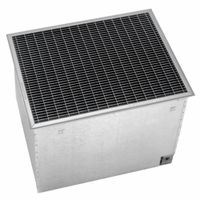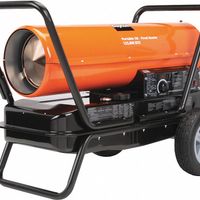Call +(254) 703 030 000 / 751 483 999 / 721 704 777
- Home
- Hvac And Refrigeration
- Heaters
- Gas Oil Kerosene Heaters
.....Read More
Frequently Asked Questions
1. How do gas, oil, and kerosene heaters work?
Gas, oil, and kerosene heaters operate by burning their respective fuels to produce heat, which is then distributed to warm a space.
**Gas Heaters:** These heaters use natural gas or propane as fuel. The gas is ignited by a pilot light or electronic ignition system. Once ignited, the gas burns in a combustion chamber, producing heat. This heat is transferred to the surrounding air through a heat exchanger. The warm air is then circulated into the room by a fan or through convection. Gas heaters can be vented or unvented. Vented models expel combustion gases outside, while unvented models release them into the room, requiring proper ventilation.
**Oil Heaters:** Oil heaters, often referred to as oil-filled radiators, use electricity to heat oil contained within the heater. The oil is heated by an electric element, and as it warms, it circulates through the heater's columns or fins. This process radiates heat into the room. Oil heaters are known for their ability to retain heat for extended periods, even after being turned off, due to the thermal mass of the oil. They are typically portable and used for supplemental heating.
**Kerosene Heaters:** Kerosene heaters burn kerosene to produce heat. The fuel is stored in a tank and drawn up through a wick. When the wick is lit, the kerosene vaporizes and burns, producing heat. The heat is radiated outward, warming the surrounding area. Kerosene heaters are often used in spaces without electricity, as they are portable and do not require an electrical connection. However, they must be used with caution due to the risk of carbon monoxide buildup, necessitating proper ventilation.
Each type of heater has its own advantages and considerations, such as fuel availability, efficiency, and safety requirements.
2. Are gas, oil, and kerosene heaters safe for indoor use?
Gas, oil, and kerosene heaters can be used indoors, but they come with significant safety considerations. These heaters can produce carbon monoxide (CO), a colorless, odorless gas that can be deadly. Proper ventilation is crucial to prevent CO buildup. Always follow the manufacturer's instructions and ensure the room is well-ventilated.
Gas heaters, including natural gas and propane models, should have an oxygen depletion sensor (ODS) that shuts off the heater if oxygen levels fall too low. Regular maintenance and inspection are necessary to ensure safe operation.
Oil heaters, often electric, are generally safer as they do not produce CO. However, they can still pose a fire risk if flammable materials are nearby. Ensure they have safety features like tip-over protection and overheat shut-off.
Kerosene heaters require careful handling. Use only 1-K grade kerosene to minimize emissions. They should be operated in a well-ventilated area and never left unattended. Refuel them outdoors to avoid spills and vapors indoors.
In all cases, install CO detectors in your home to monitor levels. Keep heaters away from flammable materials and never use them in sleeping areas. Follow all safety guidelines and consider alternative heating options if possible.
3. What are the ventilation requirements for using gas, oil, and kerosene heaters indoors?
Gas, oil, and kerosene heaters require proper ventilation to ensure safety and efficiency when used indoors. These heaters produce combustion byproducts, including carbon monoxide (CO), nitrogen dioxide (NO2), and water vapor, which can be hazardous if not adequately vented.
1. **Gas Heaters**:
- **Ventilation**: Ensure the room has adequate airflow. Use a vented gas heater connected to a chimney or flue to direct exhaust gases outside. For unvented heaters, open a window or door slightly to allow fresh air circulation.
- **Safety Measures**: Install carbon monoxide detectors in the vicinity. Regularly inspect and maintain the heater to prevent gas leaks.
2. **Oil Heaters**:
- **Ventilation**: Typically, oil heaters are vented through a chimney or flue. Ensure the venting system is unobstructed and properly sealed to prevent exhaust gases from entering the living space.
- **Safety Measures**: Regularly clean and inspect the flue and chimney. Ensure the heater is installed by a professional to meet local building codes.
3. **Kerosene Heaters**:
- **Ventilation**: Operate in a well-ventilated area. Open a window or door to provide a fresh air supply and prevent the buildup of harmful gases.
- **Safety Measures**: Use only 1-K grade kerosene to minimize emissions. Install carbon monoxide detectors and never leave the heater unattended.
In all cases, follow the manufacturer’s instructions and local regulations for installation and operation. Regular maintenance and monitoring of air quality are crucial to prevent health risks associated with indoor air pollution.
4. How efficient are gas, oil, and kerosene heaters compared to electric heaters?
Gas, oil, and kerosene heaters generally have different efficiency levels compared to electric heaters.
Gas heaters, which include natural gas and propane models, typically have an efficiency range of 70% to 90%. High-efficiency models can reach up to 98%. They are cost-effective in areas where natural gas is cheaper than electricity. However, they require proper ventilation to prevent carbon monoxide buildup.
Oil heaters, often used in portable space heaters, have an efficiency of around 80% to 90%. They are effective for heating small spaces and retain heat well, but they can be slower to warm up compared to other types.
Kerosene heaters are less common but can be efficient for temporary heating needs, with efficiencies around 70% to 85%. They are portable and useful in areas without electricity but require ventilation due to emissions.
Electric heaters, including baseboard, radiant, and convection models, are nearly 100% efficient at the point of use because all the electricity is converted into heat. However, the overall efficiency can be lower when considering electricity generation and transmission losses. Electric heaters are easy to install and use, with no emissions, making them suitable for indoor use without ventilation concerns.
In summary, while electric heaters are highly efficient at converting energy to heat, gas, oil, and kerosene heaters can be more cost-effective depending on fuel prices and availability. Each type has its advantages and limitations, and the choice often depends on specific heating needs, cost considerations, and environmental factors.
5. What maintenance is required for gas, oil, and kerosene heaters?
Gas, oil, and kerosene heaters each require specific maintenance to ensure safe and efficient operation.
**Gas Heaters:**
1. **Inspection:** Annually inspect the heater for leaks, cracks, or corrosion. Check the venting system for blockages.
2. **Cleaning:** Clean the burner and pilot light to remove dust and debris. Ensure the air intake is clear.
3. **Filter Replacement:** Replace or clean filters regularly to maintain airflow and efficiency.
4. **Thermostat Check:** Test the thermostat for accuracy and replace if necessary.
5. **Safety Devices:** Test safety devices like the carbon monoxide detector and automatic shut-off.
**Oil Heaters:**
1. **Oil Filter Replacement:** Change the oil filter annually to prevent clogs and ensure efficient fuel flow.
2. **Nozzle Cleaning:** Clean or replace the burner nozzle to maintain proper spray pattern and combustion.
3. **Chimney Inspection:** Check the chimney for soot buildup and blockages, cleaning as needed.
4. **Heat Exchanger Cleaning:** Remove soot and debris from the heat exchanger to improve heat transfer.
5. **Tank Inspection:** Inspect the oil tank for leaks or corrosion and ensure proper venting.
**Kerosene Heaters:**
1. **Wick Maintenance:** Regularly check and clean the wick. Replace it if it becomes hard or charred.
2. **Fuel Quality:** Use high-quality kerosene to prevent deposits and odors. Store fuel properly to avoid contamination.
3. **Ventilation:** Ensure proper ventilation to prevent carbon monoxide buildup.
4. **Burner Cleaning:** Clean the burner to remove carbon deposits and ensure efficient combustion.
5. **Safety Checks:** Test safety features like the tip-over switch and automatic shut-off.
Regular maintenance of these heaters not only extends their lifespan but also ensures safety and efficiency. Always follow the manufacturer's guidelines and consider professional servicing for comprehensive checks.
6. Can gas, oil, and kerosene heaters be used in tents or other temporary structures?
Gas, oil, and kerosene heaters can be used in tents or other temporary structures, but they require careful consideration and adherence to safety guidelines to prevent hazards such as carbon monoxide poisoning, fire, and burns.
1. **Ventilation**: Ensure adequate ventilation to prevent the buildup of carbon monoxide, a colorless, odorless gas that can be fatal. Tents should have vents or windows open to allow fresh air circulation.
2. **Heater Type**: Use heaters specifically designed for indoor or tent use. Portable propane heaters labeled as "indoor-safe" or "tent-safe" are preferable. Avoid using makeshift or unapproved heating devices.
3. **Placement**: Position the heater on a stable, non-flammable surface away from walls, flammable materials, and high-traffic areas to reduce the risk of tipping over or igniting nearby objects.
4. **Carbon Monoxide Detector**: Install a battery-operated carbon monoxide detector in the tent to alert occupants of dangerous gas levels.
5. **Supervision**: Never leave heaters unattended while in use. Turn off the heater when sleeping or leaving the tent.
6. **Fuel Storage**: Store fuel containers outside the tent to minimize the risk of leaks or spills that could lead to fire hazards.
7. **Manufacturer Instructions**: Follow the manufacturer's instructions and safety guidelines for operation, maintenance, and storage of the heater.
8. **Emergency Plan**: Have an emergency plan in place, including a fire extinguisher and a clear exit strategy in case of an emergency.
By following these precautions, gas, oil, and kerosene heaters can be used safely in tents and temporary structures, providing warmth and comfort in cold conditions.
7. What are the cost differences between gas, oil, and kerosene heaters?
Gas heaters typically have lower operational costs compared to oil and kerosene heaters due to the relatively lower price of natural gas. They are efficient and can be connected to a home's existing gas line, reducing the need for frequent refueling. However, the initial installation cost can be higher if a gas line is not already present.
Oil heaters, often referred to as oil-filled radiators, have a moderate operational cost. They are generally more expensive to run than gas heaters because heating oil prices can fluctuate significantly. However, they are efficient in retaining heat for longer periods, which can offset some of the operational costs. The initial purchase price of oil heaters is usually moderate, but they require regular maintenance and oil refills.
Kerosene heaters are typically the most expensive to operate due to the high cost of kerosene fuel. They are portable and do not require installation, making them a convenient option for temporary or emergency heating. The initial cost of kerosene heaters is generally lower than gas heaters but similar to or slightly higher than oil heaters. However, the need for frequent refueling and the volatile price of kerosene can make them costly over time.
In summary, gas heaters are generally the most cost-effective in terms of operation, followed by oil heaters, with kerosene heaters being the most expensive. However, the choice between them should also consider factors like installation costs, maintenance, and specific heating needs.



